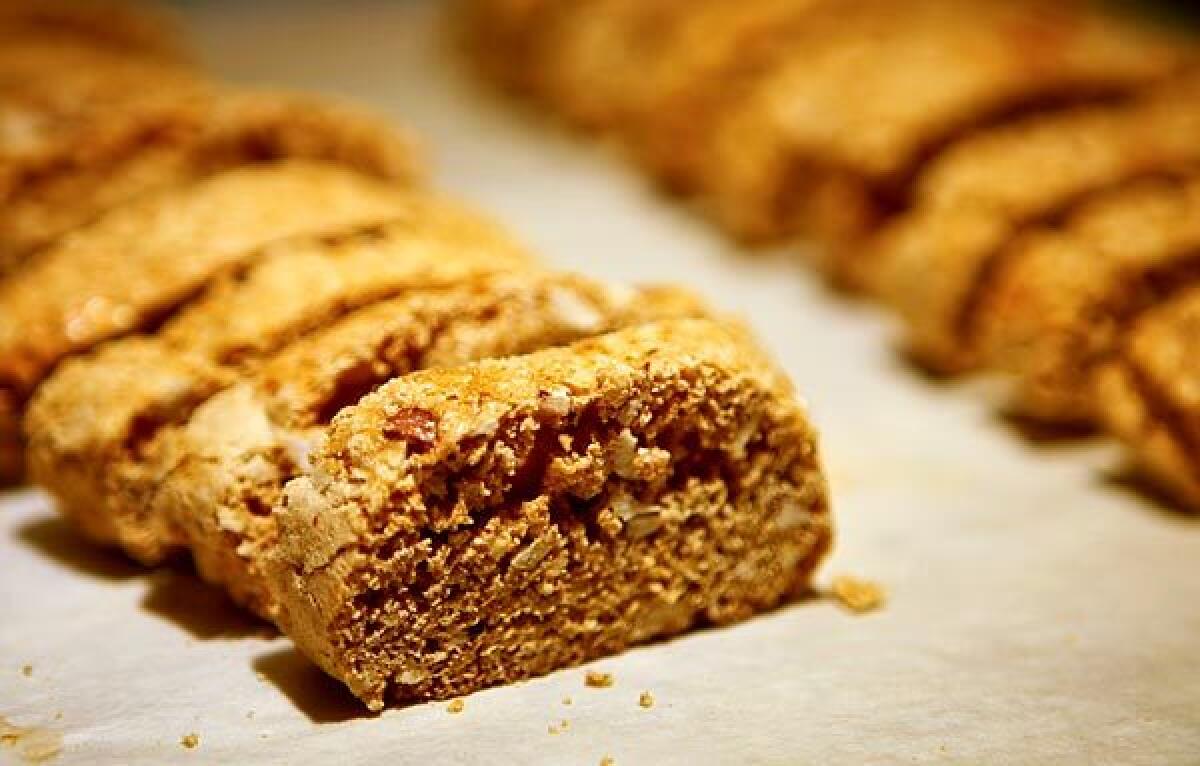Biscotti and its crunchy cousins

- Share via
If you’re Italian, it’s biscotti or cantucci. If you’re Jewish, it’s mandelbrot or mandel bread. If you’re Greek, it’s paximathakia. In Morocco, it’s fekkas, and in the Ukraine, kamishbrot. And those are just a few of the names for the twice-baked cookies enjoyed in different incarnations around the world.
“It’s a theme that runs through many, many cultures,” says food historian and cookbook author Nancy Harmon Jenkins, who explains it is the baking technique, rather than any specific recipe, that has traveled the globe.
That technique is contained in the name “biscotti,” which comes from the Latin words “bis,” meaning twice, and “coctum” or cooked.
Despite the myriad flavorings and add-ins that now enhance these cookies, they all are produced in a similar fashion: A sticky dough is shaped into logs, then baked until firm. After cooling, the logs are cut into slices and baked again at a lower temperature. This second baking draws the moisture out of the dough. The results can range from slightly crunchy to something so dry and hard it poses a serious threat to dental work.
Food historians credit bakers in Tuscany with first creating biscotti with almonds from the groves of Prato. But other cultures have their own spins. In the Greek version, orange juice, lemon rind and toasted sesame seeds give a savory flavor. Moroccan fekkas are filled with almonds and raisins. And French croquets de carcassonne are made rich with, naturellement, butter.
Lore has it that biscotti sustained Christopher Columbus on his voyages. While this conjures up the romantic image of him sitting on deck, dunking cookies in sweet wine, the reality was no doubt a lot harsher.
“It sure as hell wasn’t biscotti; it was hardtack and it was probably disgusting,” says food historian and author Clifford A. Wright, winner of the James Beard book of the year award for “A Mediterranean Feast.”
Wright says that hardtack was an invention that came about after the appearance of hard wheat, around 900 AD. Before that time, perishable soft wheat was used to bake bread. When hard wheat was discovered, it was difficult to grind into bread flour, so other products were invented for it, including pasta, couscous and hardtack.
In her book “From Hardtack to Home Fries,” food historian Barbara Haber describes hardtack as a dietary mainstay in the military during the Civil War: “So notoriously hard was the cracker that it was the constant subject of derisive songs and jokes, like the one about the Kansas soldier who found something soft in his hardtack — a ten-penny nail.”
As the unappetizing name implies, hardtack was a solid wafer made from flour, water and salt. It introduced the double-baking method as a way to remove moisture, giving the biscuits a long shelf life.
“Baked this way they lasted for weeks. It’s easy to see how they became staples for sailors and shepherds,” Jenkins says.
You don’t have to be Darwin to form an evolutionary theory linking twice-baked hardtack to biscotti. But how bakers made the leap from a plain cracker to a crisp treat bursting with flavor is not known. Did soldiers and sailors introduce the biscuits to new lands, where the cookies were transformed?
“Very hard to say,” Wright says. “One of the problems is that sailors didn’t take notes. We have very little in the way of following the history of these kinds of foods.”
Is it too much of a stretch to picture a creative baker tasting hardtack and thinking: “You know, this would be a whole lot better if I added a cup of toasted almonds”?
Jenkins says that the many varieties in biscotti may have arisen simply from “economical country people providing for themselves with the ingredients at hand.”
Today, biscotti are more popular than ever, with hundreds of recipes in play. A key variation is in the fat used or, sometimes, left out. For example, modern mandel bread recipes call for canola oil, resulting in a moderately crunchy cookie with a mild taste. Greek paximathakia uses sassier olive oil. The egg-less dough is kneaded, giving it a bready consistency. Butter in the French version creates a tender texture, almost like shortbread. And a traditional Italian cantucci uses no oil at all. Instead, hazelnuts or almonds provide moisture and flavor, with eggs binding the ingredients.
The amount of sugar also differs, with traditional European recipes employing the “less is more” philosophy.
“Most Italian so-called sweets and cookies are not sweet at all, they’re very mild,” says Wright. “Americans have a sweet tooth and they overdo it. I can’t think of anywhere that uses chocolate chips the way we do.”
Guilty as charged. I’ll confess to taking a traditional family mandel bread recipe and punching it up with cocoa and white chocolate chips.
When I bake this, my daughter always asks me to save her some “raw” pieces. By this she means still-soft cookies that are plucked off the tray before the second baking.
As Jenkins observes: “The world is divided between the lovers of soft cookies and dry cookies.”
She puts herself into the latter category, along with so many other people across the globe, who are content to end meals with a few perfectly crisp twice-baked cookies — by whatever name they call them.
More to Read
Eat your way across L.A.
Get our weekly Tasting Notes newsletter for reviews, news and more.
You may occasionally receive promotional content from the Los Angeles Times.










